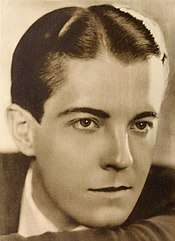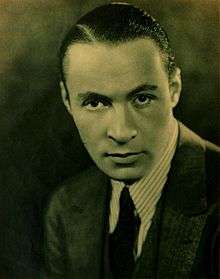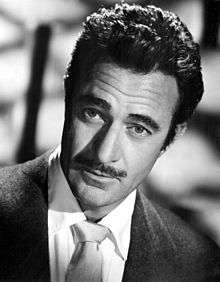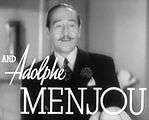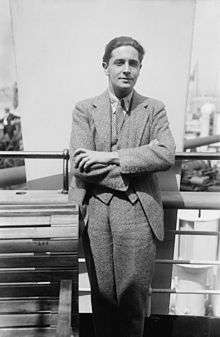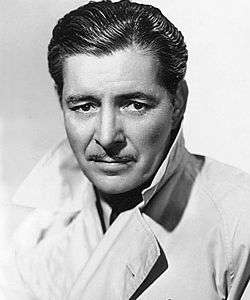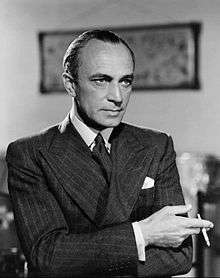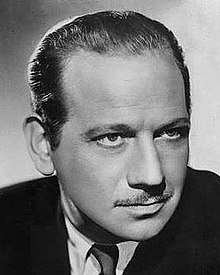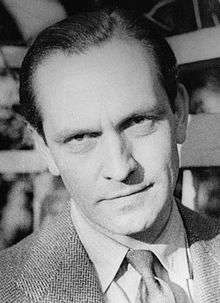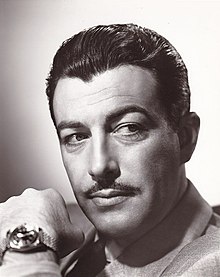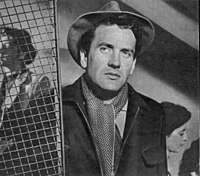Latin lover
Latin lover is a stereotypical stock character, part of the star system. It appeared for the first time in Hollywood in the 1920s for Italian actor Rudolph Valentino and, for the most part, lost popularity during World War II.[1]

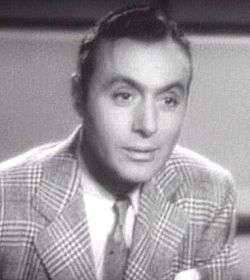

Characteristics
The Latin Lover was the first male acting type in the history of filmmaking whose behavior and destiny are set through his love relations with a woman, hence ‘lover’ though, as the type was depicted in the beginning, the term ‘seducer’ would be more suitable.[1] Major characteristics describing the type include:
- appearance; he is always handsome or, for the reigning standard of the period, different or atypically looking.
- behavior; the way he conquers women, using focused, sharp glare, and certain mannerism characterized by outbursts of passion, dancing, etc.
- type of roles; he is usually a romantic, exotic hero and foreigner, mostly a historical person or character in literature, often a victim of an intrigue which insinuates the doomed affair.
- genre; mostly melodramas, and if it happens to be some other type of a movie, it must have melodramatic overtones.[1]
When he appeared, the Latin Lover was opposed to the absolutely dominant type of male character in Hollywood at the time, a man of action, who represented a fighter for justice, freedom or some other cause. At the same time, the Latin Lover was the first distinct non-American type. It was the result of several factors: crisis of faith in the supremacy of a male as a consequence of the horrors of World War I, growing female emancipation but also Hollywood’s effort to conquer the film markets of Europe, whose audience was deemed more refined at the time. Due to the non-American attributes of the type and a fact that a noticeable number of European actors moved their careers to Hollywood, some film historians, like Enno Patalas, prefer the term ‘stranger’ instead of a ‘lover’.[1]
Origin
Because of the American idea what a Latin Lover (Italian: amante latino, Spanish: amante latino) should look like (dark hair, darker complexion), initial representatives of the type were indeed of Mediterranean or Latin American origin. The first was the Italian-born actor Rudolph Valentino, for whom the term Latin Lover was created. Director George Fitzmaurice, who directed Valentino in several of his movies, was very important for the launching of Latin Lover character. Valentino is universally considered as the supreme representative of the type in film history. A symbol of what a lover should be and look like in the 1920s, his enormous popularity was enhanced by his unusual personal life and the fact that he was the first male star whose private life was compared to those of the characters he played. The Valentino myth was sealed with his premature death at the age of 31. Later, the term included Mexican-born actor Ramon Novarro and other typecast actors followed, like Maurice Chevalier, Ricardo Cortez, Antonio Moreno, Gilbert Roland, Jack La Rue, Rod La Rocque, Charles Boyer, Victor Mature, Frank Sinatra, Robert Alda, and Adolphe Menjou, the first who brought a certain measure of cynicism to the type.[1]
As the Latin lovers rapidly gained popularity with the audience, the ‘non-Latin’ characteristics increased, so the variations of the type developed, which made the use of ‘stranger’ instead of ‘lover’ more acceptable. In Great Britain, the originator was Ivor Novello and Ronald Colman added the Englishness, creating the type of an English gentleman. Central European and local German flavors were presented by Erich von Stroheim and Conrad Veidt, respectively, while a very popular French exemplar was Ivan Mosjoukine.[1]
When it comes to the American actors in the later silent period, almost without any competition from other fellow actors, the type was embodied by John Barrymore and John Gilbert. In the sound period, most popular American actors of the type were William Powell, Fredric March, Melvyn Douglas and commercially extremely successful Robert Taylor and Tyrone Power. The ‘French lover cliché’ type was created by Charles Boyer, while popular British actors, prior to World War II, include Laurence Olivier, Leslie Howard, Robert Donat, David Niven and James Mason. Britons in general added much more realism to the type, while Mason represented a bit of a ‘sadistic’ derivative. Massimo Girotti was an Italian version.[1]
Though actors like Douglas Fairbanks and Anthony Quinn are sometimes placed in this category,[2][3] they actually belonged to the adventurer or the swashbuckler type.[1]
After World War II
Outbreak of the war made the type look totally obsolete, so after the war ended only rare actors appeared in the type, and even then, only for the short period of their careers: Louis Jourdan and Gérard Philipe in the late 1940s, Tony Curtis and Rossano Brazzi in the 1950s and Omar Sharif in the late 1960s. Marcello Mastroianni did some type acting but also very effectively evoked and parodied it in several roles, while only partially it was represented by Robert Redford, Burt Reynolds, Gérard Depardieu and Michael York in the 1970s. Still, the type survived through the 1980s in the cinema of South America[1] and was revived to some extent in the 1990s with Antonio Banderas.[4][5]
Other Latin Lovers of the world cinema, partially or through their whole careers, include Warner Baxter, Iván Petrovich, Pierre Blanchard, George Raft, Cesar Romero, Victor Mature, Don Ameche, Jean Marais, Frank Sinatra, Robert Alda, Rossano Brazzi, Mario Lanza, Dean Martin, Erno Crisa, Fernando Lamas, Franco Fabrizi, Mario Lanza, Ricardo Montalbán, Yves Montand, John Saxon, Sal Mineo, John Gavin, Bobby Darin, George Hamilton,[1][5][6] Jean-Paul Belmondo, Alain Delon, Al Pacino, Robert De Niro, Sylvester Stallone, John Travolta, Matt LeBlanc, Andy García,[3] Olivier Martinez[7] and Vincent Perez.[2]
In time, the term spread to other arts, like the music, with typical representatives being father and son Frank Sinatra and Frank Sinatra Jr., and Julio Iglesias and Enrique Iglesias.[6]
Gallery
|
|
References
- Filmska enciklopedija, Vol. II, page 20-21. Jugoslavenski leksikografski zavod Miroslav Krleža, Zagreb. 1990.
- Deborah Hornblow (10 May 2002). "Why The Latin Lover Is Hollywood's Type". Orlando Sentinel.
- Victoria Thomas (1998). Hollywood's Latin Lovers: Latino, Italian and French Men Who Make the Screen Smolder. Angel City Press. ISBN 978-18-8331-841-3.
- Viviana Ojeda (August 10, 2016). "Antonio Banderas, The Latin Lover, & Other Latin Stereotypes". Odyssey.
- Thomas Schatz (2004). Hollywood: Cultural dimensions: ideology, identity and cultural industry studies. Taylor & Francis. ISBN 0415281318.
- Robert Dominguez (12 February 2014). "Hollywood's Latin Lovers have a long and lurid history". New York Daily News.
- Camilla Piccitto (16 May 2011). "Olivier Martinez - The cool look of a modern Casanova". Vogue.
Further reading
- Enno Patalas, Sozialgeschichte des Stars, Hamburg, 1963.

